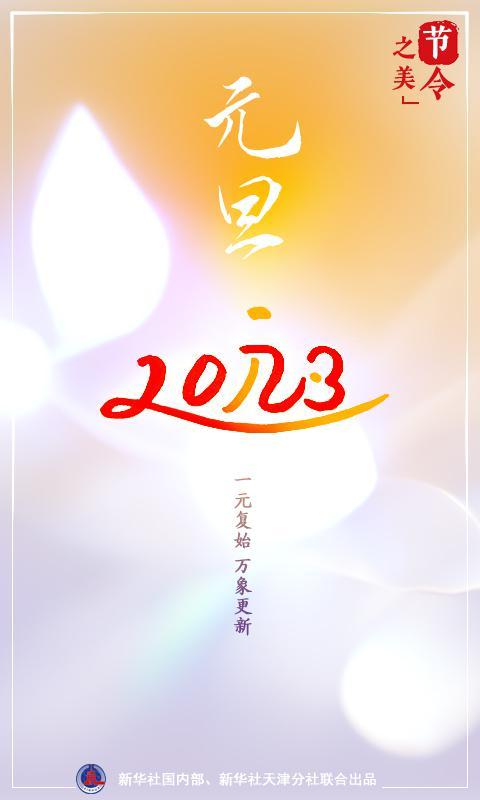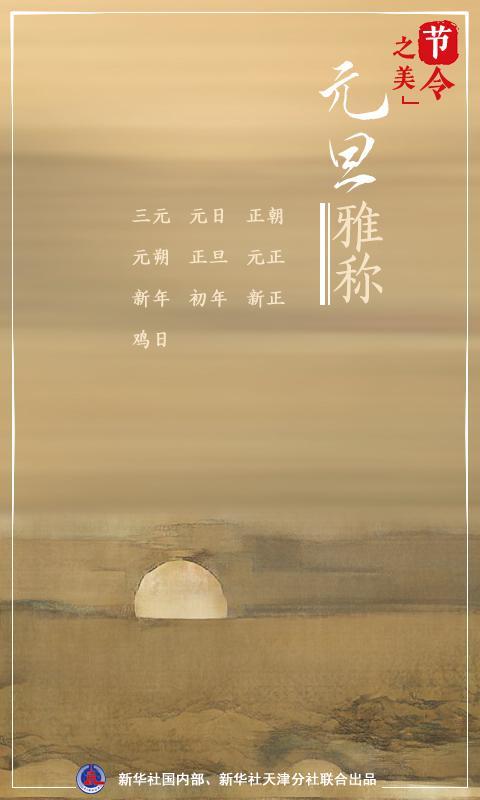A unified start, Vientiane update. January 1, 2023 is the first day of the Gregorian New Year, and people are used to calling it New Year’s Day. What does the word New Year’s Day mean? What’s the nickname? What is the relationship between modern Spring Festival and ancient New Year’s Day? Listen to what folklore experts say.
Poster production: Feng Juan
Xiao Fang, a professor at the School of Social Studies of Beijing Normal University and director of the China Festival Culture Research Center of China Folk Writers Association, said in the Song Dynasty that "the first month of the first month is called New Year’s Day, and the common name is New Year’s Day. One-year-old festival, this is the first. " Literally, Yuan is the beginning and Dan is the morning. As a holiday time, it refers to the morning of the first day of the first month of each year, that is, the beginning of the new year.
Historically, there are many elegant terms for New Year’s Day, such as Sanyuan, Yuanri, Zhengchao, Yuanshuo, Zhengdan, Yuanzheng, New Year, Early Year, Xinzheng, Chicken Day, etc., but among many terms, "New Year’s Day" is the most common and the longest.
Poster production: Feng Juan
Traditional China society has a different understanding of the "new year" from the west, and has always regarded "the first day of the first month" as the beginning of the "new year", which was the case in ancient China, and New Year’s Day was the "first day of the first month". Before Emperor Wu of the Han Dynasty, the specific date of New Year’s Day was not uniform. The Xia Dynasty was the first day of the first month of the first lunar month, the Shang Dynasty was the first day of the second lunar month, the Zhou Dynasty was the first day of the first lunar month, and the Qin Dynasty was the first day of the first lunar month. During the reign of Emperor Wu of the Han Dynasty, he switched to taichu calendar, redesignating the first day of the first month of the first lunar month in the summer calendar as "New Year’s Day", which has since been used by successive dynasties.
"It can be seen that in a long historical period, there was only one New Year in China, which was the lunar year on the first day of the first month. This situation was not changed until the Republic of China." Xiao Fang said.
In 1911, the Revolution of 1911 overthrew the rule of the Qing Dynasty. The newly established government of the Republic of China introduced the western calendar, and began to use the Gregorian calendar in 1912, stipulating that January 1 of the Gregorian calendar was the New Year, and appropriated the name "New Year’s Day" originally used as the Lunar New Year to the Gregorian New Year, and the Lunar New Year was renamed the Spring Festival. Since then, China people have had two New Years every year: one is New Year’s Day on January 1 of the Gregorian calendar, which people used to call "Gregorian Year"; The other is the Lunar New Year, the Spring Festival, on the first day of the first lunar month.
"However, due to historical culture and folk traditions, the holiday revision of this calendar has not become widely popular." Xiao Fang said.
On September 27th, 1949, the first plenary session of China People’s Political Consultative Conference passed a resolution, and People’s Republic of China (PRC) adopted the AD calendar year. Since then, January 1st of the Gregorian calendar has been officially called "New Year’s Day" and the first day of the first lunar month has been designated as "Spring Festival".
"As the first day of the Gregorian New Year, New Year’s Day is a legal holiday in many countries or regions in the world. It is full of vitality, symbolizes new life and new hope, and also places people’s good wishes and expectations for the future." Xiao Fang said.
Coordinator: Liu Xinhui and Liu Yuanxu
Reporter: Zhou Runjian
Editor: Li Min
Jointly produced by Xinhua News Agency and Tianjin Branch.
Produced by Jieling Studio


关于作者